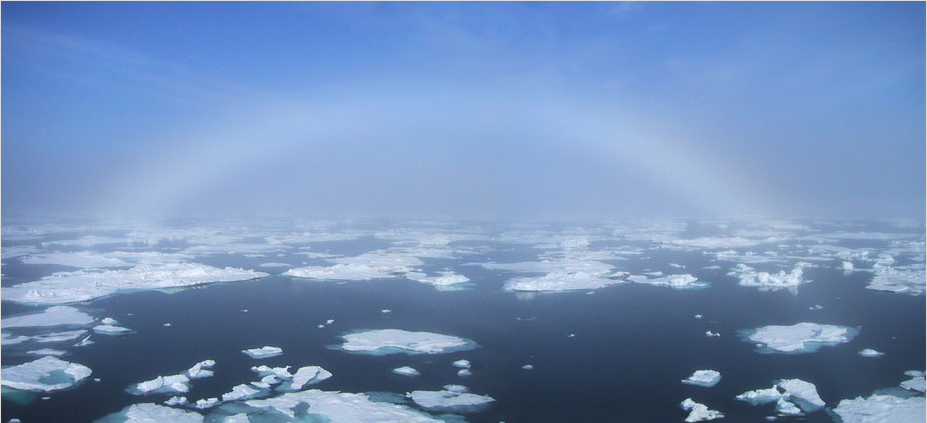Arctic fogbow
Arctic Fogbow: A Mystical Optical Phenomenon
The Arctic region is known for its stunning natural wonders, and one such captivating spectacle is the Arctic fogbow. This atmospheric optics phenomenon occurs when sunlight interacts with tiny water droplets suspended in the air, creating a breathtaking bow of colors. While similar to a rainbow, the Arctic fogbow has its own unique characteristics that make it a mesmerizing sight to behold.
The Formation of Arctic Fogbows
Arctic fogbows are formed under specific conditions where fog or mist is present in the air. When sunlight passes through these tiny water droplets, it undergoes a process called refraction. This bending of light causes the different colors within sunlight to separate and form a circular arc. The droplets in fog are typically smaller than raindrops, which results in a fogbow having fainter colors and a wider shape compared to a traditional rainbow.
The Delicate Hues of an Arctic Fogbow
One of the distinguishing features of an Arctic fogbow is its delicate color palette. While rainbows are known for their vibrant hues, fogbows display more subdued tones. The lower sections of an Arctic fogbow appear stronger and often showcase distinct red and yellow outer edges. These subtle color variations add to the ethereal beauty of this optical phenomenon.
The Perfect Viewing Conditions
To witness an Arctic fogbow, specific atmospheric conditions must align. Firstly, there needs to be fog or mist in the air, typically near cold ice or ocean surfaces. Secondly, the fog layer should not extend very high into the atmosphere. These factors create the ideal environment for the formation of an Arctic fogbow.
Captivating Sightings in the Arctic
Arctic fogbows can be observed from various vantage points, including the decks of ships or from high vantage points on icebreakers. These unique viewpoints offer a different perspective on this enchanting phenomenon. Visitors to the Arctic, such as Ann Bowker from Cumbria, England, have been fortunate enough to witness the beauty of an Arctic fogbow firsthand. Ann spotted a fogbow near Franz Josef Land in the Arctic Ocean, approximately 81°N. Her sighting on July 18th, 2002, captured the essence of this captivating spectacle.
Similarities and Differences to Rainbows
While Arctic fogbows share similarities with rainbows in terms of their formation through the interaction of sunlight and water droplets, they also possess distinct characteristics. Some notable differences between the two include:
- Color intensity: Fogbows have more muted colors compared to the vibrant hues of rainbows.
- Shape: Fogbows are wider and often lack the secondary bow seen in rainbows.
- Visibility: Fogbows are generally fainter and can sometimes appear ghostly due to the smaller droplets present in fog.
The Science Behind the Beauty
Understanding the science behind Arctic fogbows enhances our appreciation of this natural wonder. The phenomenon is a result of light refraction and dispersion, where sunlight bends and separates into its component colors as it passes through tiny water droplets. The size of these droplets affects the appearance of the fogbow, with smaller droplets producing a wider and fainter bow.
A Mystical Encounter
Witnessing an Arctic fogbow is a truly mystical encounter. As you stand amidst the Arctic landscape, surrounded by fog and mist, the bow of delicate colors appears before your eyes. The ethereal beauty of this optical phenomenon evokes a sense of wonder and awe, reminding us of the mesmerizing wonders that nature has to offer.
Conclusion
The Arctic fogbow is a captivating atmospheric optics phenomenon that enchants all who are fortunate enough to witness it. With its delicate hues, wider shape, and unique viewing conditions, the Arctic fogbow offers a distinct visual experience. Whether observed from a ship's deck or the heights of an icebreaker, the sight of an Arctic fogbow is a reminder of the mystical beauty that can be found in nature. So, if you find yourself in the Arctic region, keep your eyes peeled for this enchanting spectacle and prepare to be mesmerized by its ethereal allure.

Fogbow over the Arctic Ocean near Franz Josef Land approx. 81°N. Ann Bowker of Cumbria, England (Mad about Mountains) saw this bow on 18th July 2002 in the fog layer close to the cold ice and ocean surface. The fog layer does not extend very high and the bow's lower sections are strongest with distinct red and yellow outer edges. The vantage point was high on the superstructure of an icebreaker. ©2002 Ann Bowker, shown with permission.
Note: this article has been automatically converted from the old site and may not appear as intended. You can find the original article here.
Reference Atmospheric Optics
If you use any of the definitions, information, or data presented on Atmospheric Optics, please copy the link or reference below to properly credit us as the reference source. Thank you!
-
<a href="https://atoptics.co.uk/blog/arctic-fogbow/">Arctic fogbow</a>
-
"Arctic fogbow". Atmospheric Optics. Accessed on April 20, 2024. https://atoptics.co.uk/blog/arctic-fogbow/.
-
"Arctic fogbow". Atmospheric Optics, https://atoptics.co.uk/blog/arctic-fogbow/. Accessed 20 April, 2024
-
Arctic fogbow. Atmospheric Optics. Retrieved from https://atoptics.co.uk/blog/arctic-fogbow/.